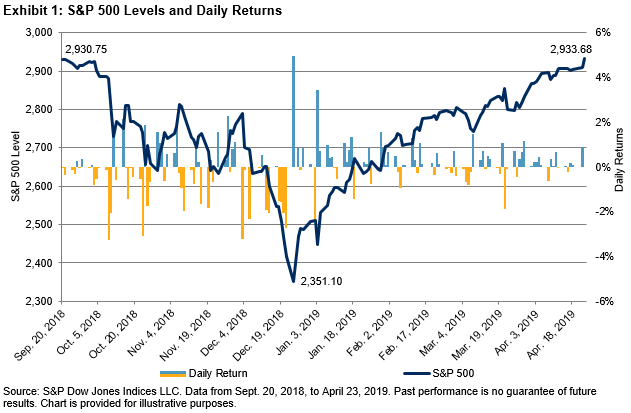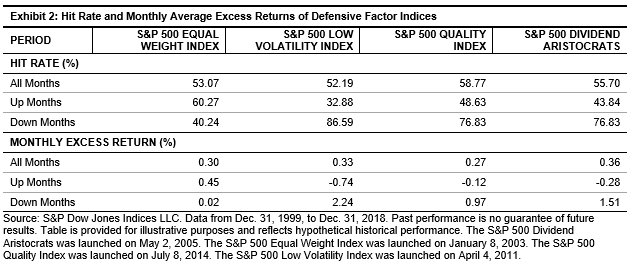As we close the first quarter of 2019, we see that Latin America did well for the period. The broad regional index, the S&P Latin America BMI, yielded nearly 9% and the S&P Latin America 40, representing the blue-chip companies in the region, generated returns just shy of 8%. These were in line with the returns for equity markets in Europe and Japan, where the S&P Europe 350® and the S&P/TOPIX 150 generated returns of 11% and 8%, respectively. The U.S. market did exceptionally well, with the S&P 500® gaining nearly 14% for the quarter.
All of the GICS® sectors in Latin American did well, except for Consumer Discretionary, which remained flat. The sectors that significantly contributed to the region’s performance in Q1 were Energy and Utilities, generating 19% and 14%, respectively.
At the country level, Argentina had a strong quarter, generating 10.5% in ARS as measured by the S&P MERVAL Index. The broad country index, the S&P Brazil BMI, gained around 9% in both USD and BRL. Chile’s S&P/CLX IPSA gained 3% in CLP. The S&P Colombia Select had a stellar quarter, gaining 19% in COP. Mexico’s headline index, the S&P/BMV IPC, returned over 4% in MXN. Finally, Peru’s blue-chip index, the S&P/BVL Peru Select, returned nearly 10% in PEN. Overall it was a great first quarter for markets in the region.
When we look at the other segments of each market, we find indices that not only did well in Q1 2019, but also have been consistently positive over longer periods. A good example of this is the S&P Dividend Aristocrats Brasil Index, which gained nearly 13% for the quarter but also had a strong yield of 6.1%, providing investors with double gains. Likewise, the S&P/B3 Enhanced Value had unsurpassed returns of 35% for the one-year period and 39% for the three-year period ending March 2019. In Chile, the S&P/CLX Chile Dividend Index outperformed the country’s flagship index in terms of both returns and yield. Mexico had a good quarter, but many of its core indices were still in the red for the year and longer time horizons. However, there are a few shining stars that have managed to remain on the positive side for the short- and mid-term periods. Some examples of these are the multi-factor S&P/BMV IPC Quality, Value & Growth, the S&P/BMV FIBRAS Index, and S&P/BMV China SX20 Index. In Peru, the Consumer Staples and Financials sectors have proven to be the most consistent performers over the years.
As we continue through the first half of the year with three months gone and nine more to follow, it’s an opportune time to get a feel for the economies of Latin American countries. For 2019, the general sentiment of global economists for the region is positive. 2018 was a year of elections and new governments for many Latin American countries. In 2019, we are starting to see some of these changes take effect, although it is too early to see the actual impacts. Brazil is now armed with new pro-reform leaders, and its GDP is estimated to grow to 2.4% in 2019. As the U.S. economy is expected to slow down, Mexico, which is partly dependent on its northern neighbor, may be seeing a GDP growth of just under 2%. Additionally, the still-pending ratification of the USMCA agreement (formerly NAFTA) and the uncertainty of the new Mexican government’s policies are dampening the economic outlook for 2019. On the positive side, the GDP of Chile, Colombia, and Peru is estimated to increase 3.3%, 3.1%, and 3.8%, respectively. Argentina, which will have presidential elections later this year, is the only country expected to contract by about 1% in 2019, but has a positive outlook for 2020.[1]
Will these positive economic expectations translate into positive market performance? The answer is maybe. Markets with strong economies do not always generate strong results, and vice versa. However, economic fundamentals help to measure the perceived value of companies. Supply and demand, consumer confidence, credit, and market psychology are all factors that affect the value of a stock directly and indirectly, so it is important to see how our markets’ policies and expectations are developing in order to have a sense of what’s to come.
For more information, check out the Q1 2019 Latin America Scorecard.
[1] FocusEconomics. www.focus-cconomics.com. Feb 12, 2019. Country reports.
The posts on this blog are opinions, not advice. Please read our Disclaimers.
















